Paul Nash’s Geological Enigma
Paul Nash’s Geological Enigma
By Anna Reid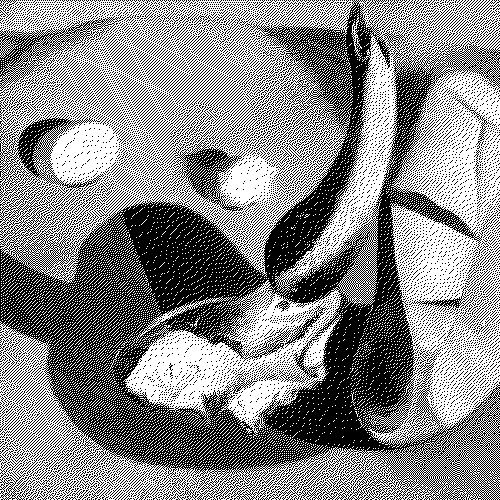
Abstract
This essay explores the* *attunement of Nash’s work to pioneering geophysical research in England, connections which have not yet been fully recognized. In a context of the early-to-mid twentieth century, when geophysicists read the startling radioactivity of the land and worked mathematical equations to put a vastly ancient and sensational new age on the rocks of the earth, Nash’s landscape works, fraught with mathematical problems, equations, stones and bones, resonated afresh, beyond the confines of the Modern. Through these interests, I argue, Nash channelled and revitalized a British tradition of engagement with the aesthetics of the geological.
1Last summer I walked in a field near Avebury where two rough monoliths stand up … miraculously patterned with black and orange lichen, remnants of the avenue of stones which led to the Great Circle. In the hedge, at hand, the white trumpet of a convolvulus turns from its spiral stem, following the sun. In my art I would solve such an equation (fig. 1).1
This essay describes how, when read in the context of geological knowledge, the landscape work of Paul Nash exhibits a prescient realism and evinces experimentation amidst a new era of empirical research.2 In this, Nash’s landscapes can be perceived as a form of geological material, posing geological problems and enigmata. Nash’s affinity with the geological is legible throughout his oeuvre. A range of books contained in the artist’s library evidence his interest in natural science and geological process. Nash’s work is part of a tradition of engagement with the geological, inherited from John Ruskin and William Blake before him. Considered as such, Nash’s aesthetics of the land is brought more sharply into view—its preoccupation with deep history and invisible, dynamic morphologies. This reading does not contradict Nash’s spiritual and other interests, but rather reads him as an artist whose experimental work moves between dimensions and domains.
2
Nash worked in a context of astounding geological discovery: that of a radioactive earth legible by mathematics—a new geological real. The attunement of Nash’s work to this discovery is under-recognized. This is partly owing to the concurrence of his work with the emergence of modernist critical thought in Britain, which exactly rejected the possibility of ontological description and its history in art. Critical thought of modernist origins has now been decentred by the engagement of artists with pressing matters of the geological real. Nash’s work, read as intense realism, offers a rich precedent to realisms of the twenty-first century. It guides the eye towards dynamic geological problems and curiosity.
An English Landscape Artist
Nash’s work tends to be described first as “English”.3 I propose that the English concept of the land at play in the work has to do with universal new insight gained through geological discovery. From the perspective of a modernist critic in England, driven by the imperative to break with the immanent in pursuit of international critical dialogue, Nash’s refusal to relinquish the landscape appeared at best insular.4 Yet the “English” adjective is invested in a way that does not contradict the modern reverence for the virtuosity of human perception above and beyond the immanent land.
3Over the course of Nash’s working life, scientists in England were engaged with a startling new geophysical understanding of the earth. Observations by Marie and Pierre Curie, dating from 1898, had pointed to a land alight with radioactive processes previously unknown and entirely unsuspected. Working in England in 1905, the physicist Ernest Rutherford had used the rate at which radium decays into helium to produce estimates of the age of mineral samples. The English geologist and physicist Arthur Holmes then conducted pioneering research into radioactive processes. As a physics undergraduate at Imperial College, London, he had taken a course in geology, which led him to trace the rates of decay of uranium into lead. Holmes had published a resplendent new geological reading of the land in the first (1913) edition of his The Age of the Earth (fig. 2). It detailed mesmerizing earth processes: uranium halos, atoms sparking and bursting like rockets, flashing zinc sulphide, Beta and Gamma Rays, pitchblende glowing with light in the darkness, “Man putteth an end to the darkness and exploreth to the utmost limit the stones of darkness.”5
5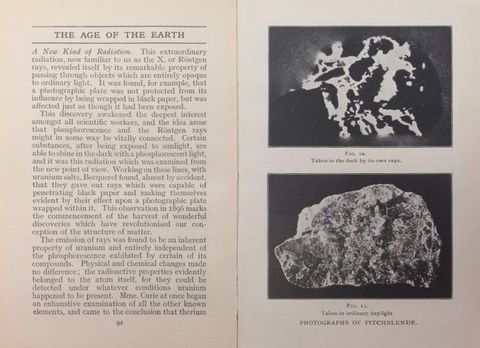
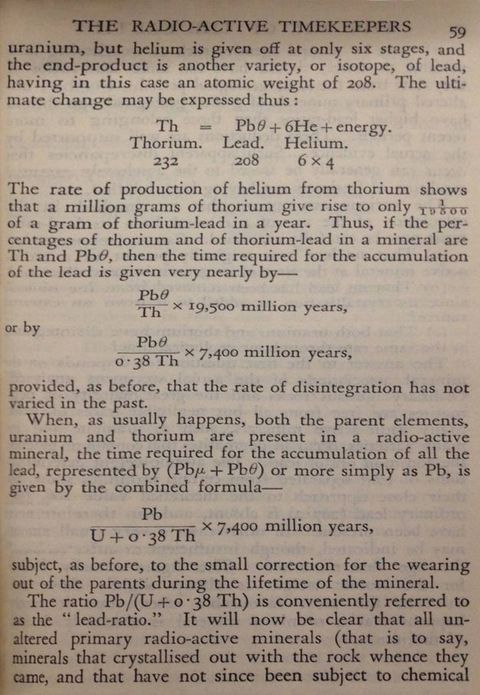
Holmes proceeded to work with the physicist Frederick Soddy, who had discovered that elements exist in diverse isotopes. They worked together using mathematics to read complex sequences of radioactive decay from one isotope to another, occurring in diverse rock samples. From these legible sequences arose new “radio-metric” dating (fig. 3). Holmes worked complex and elegant equations to put an age of 370 million years on a mineral in a Devonian Norwegian rock, astoundingly older than the extant estimated age of the earth at 100 million years.6 Three editions of Holmes’s book gave vivid and accessible accounts of this new vision of an abundant land, vast in time. The 1927 edition was part of the Benn Sixpenny Library, which was aimed at a general audience. The new research was well known in the public domain. From 1929, the BBC published The Listener as a weekly magazine and it covered the new geological breakthroughs (Nash wrote art criticism and reviews for The Listener on a regular basis). The science section of the very first edition featured “Revolutionary Discoveries”, a text describing spontaneous radioactivity:
67The very materials with which we are most familiar are found to be in constant flux, and are liable to change from one form to another. The atoms of matter had been thought to be permanent and stable … unalterable foundation-stones of the material universe … these atoms were found by brilliant experimenting to be not constant and inalterable at all: neither were they inert.7
The artist’s own book collection includes a copy of The Mysterious Universe, printed after a 1930 Rede Lecture given at the University of Cambridge by the British astrophysicist Sir James Jeans, and dedicated to “the new world of modern physics”. It details “matter and radiation” and “the diffraction of light and electrons”, and describes “a kaleidoscopic rearrangement of scientific thought”. The work of Rutherford and Soddy is set out: theories of “spontaneous disintegration”, “cosmic radiation”, X-rays, radioactive substances, and the disintegration of the radium atom.8
8During the inter-war period, the science community was receptive to the concept of the land as being more complex, intricate, and legible than ever imagined—a land replete with new avenues for research. Amidst increasingly precise radiometric estimates at this time arose another equation which was solved: putting an age on the earth of 3 billion years.9 A historian of geology, Martin Rudwick, has noted the universal implications, not only for the earth itself but also for the earth in relation to the sun, the solar system, and the cosmos.10 He cites the geologist William Sollas, who remarked in 1921 that the geologist who before had been “bankrupt” in time, now finds himself suddenly transformed into “a capitalist with more millions in the bank than he knew how to dispose of.”11
9This was not the first occasion of geological revelation in the British context. Ruskin’s vision of landscape, which had been cast aside by the modern’s imperative, derives from the first insights of geology as they played out in the nineteenth century. Ruskin’s evangelical torsions tend to obscure his vital original aesthetics, which went hand in hand with the founding insights of geological science. The new science recognized, in the superpositions of the land, an earth that was quite removed from the theological narrative of a young anthropocentric earth of only 6,000 years, created for and simultaneous to man. Ruskin studied with William Buckland, the first reader in geology at Oxford. Buckland was opening a space for the new science at a university that was principally dedicated to the training of clergymen. In his Modern Painters (1843–1860), Ruskin urged artists to study geology. His interest in Turner was as a painter of vital new geological truth, and of The Fall of the Tees, he said: “With this drawing before him the geologist could give a lecture upon the whole system of aqueous erosion” (fig. 4).12
12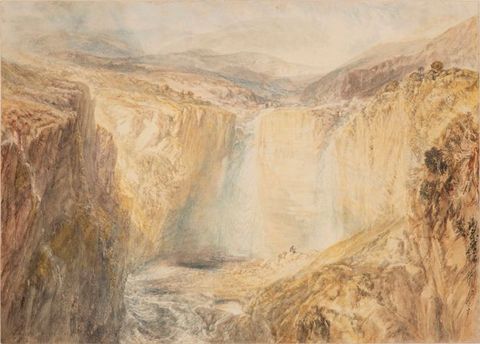
William Blake’s poetic visions are also replete with imagery of British rocks, mountains, and ancient sites. Noah Heringman describes Blake’s orientation towards the primordial matter of the land, his connections to the geologist George Cumberland, and how “Blake’s poetry shares the cosmological interest of geology, both registering and critiquing the wonder provoked by geological forms and processes.”13 Going back further, to the seventeenth century, the footwork between poetic and scientific work on the geological landscape in the British context has been explored by the historian Stephen Gould, who foregrounds the role of Thomas Burnet’s 1681 Sacred Theory of the Earth in instigating geological thought, to contradict “whiggish” accounts of geological history, which pit rational empiricism against the theological and poetic.14
13Unseen Landscapes
Throughout the British landscape tradition, there is an impetus to devise new strategies to visualize previously unknown or unseen dimensions of the land. This could be described as the geological impetus. Nash certainly took an active interest in mysterious physical phenomena.15 In his contribution to the book Unit One: The Modern Movement in English Architecture, Painting and Sculpture, which presented the work of the artists’ group founded by Nash, he refers to his imaginative research in the “hidden” land.16 He recalls the hidden land that is gleaned in the work of Turner, Blake’s ancient Britain, Albion, and the renewed task of the landscape artist. Nash’s endeavours have often been read as Blakean, as seeking the spirit of the land or place, the genius loci. In this, and in a recent neo-romantic reading, Nash’s hidden land is envisaged as a spiritual sphere and realm of the mind, theological, and connected to Christian Science’s “soaring rhetoric of spirit over the material world”.17 A reading with geological context can pull Nash’s unseen land back to a material dimension, less emanating spirit of place and more as land that is literally emanating radioactivity.
15In 1927, Holmes described a magnificent unseen earth, veined with radioactive minerals from Ceylon to St Ives, Katanga to the Mourne Mountains. He detailed the high-velocity ejections of electrically charged helium atoms that are Alpha “rays”, long and intricate patterns of transformations that can be traced, “each accompanied by an explosive liberation of energy”.18 These revolutionary discoveries were described as “the processes going on in a garden”.19 Nash’s Unseen Landscape too, as he describes in his May 1938 article of the same name for Country Life magazine, is a land of “stones, bones, empty fields … back gardens” alive with new intrigue and offering “endless possibilities of fresh adventure”. His is a view of land seething with processes of decay and transformation: petrified forests, bleached objects, blanched springs and branches, “mutilated by shafts of light”. It is not a residual landscape, but one with the “terrific animation” of the landscape of the white horse*,* flickering as the eye moves across it, traversed by the radiance of the sun and the moon, “beating down on glinting white”20 (fig. 5, fig. 6, fig. 7).
18
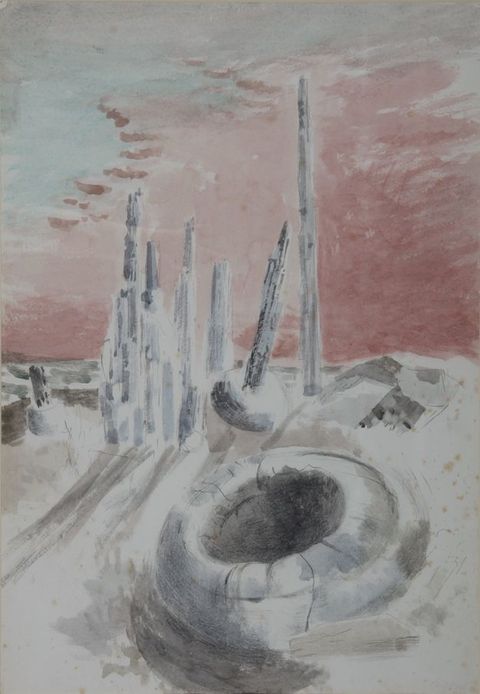
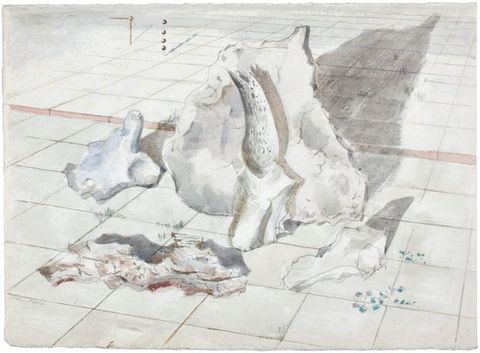
This is not a Victorian, theological, unseen land, read and presented as a display of moral insight. Nor is it a lost spiritual origin: a “fallen” materiality, a denuded, romantic land. In the same text, Nash distinguishes his “first” vision of the “wild privacy” of this unseen landscape from its romantic and theological forebears, describing it as “neither moral nor sentimental nor literary” in character. The unseen landscapes that Nash envisages, he reconfirms, “are not part of the unseen in a psychic sense … They belong to the world that lies, visibly, about us.” They are “The Invisible World(s)” of the type portrayed by the science and geology books that Nash owned: “Cities built of Microscopic Shells”; “The Air and its Corpuscules”; or the electric processes of “The Aurora Borealis seen from the Arctic Sea”.21 Nash’s hidden lands are “unseen merely because they are not perceived; only in that way can they be regarded as ‘invisible’.”22 They are a materiality that is not visible to the unaided eye.
21In 1926, Holmes described his research, citing Swinburne: “man can see through the years flowing round him, the law lying under the years”23 (fig. 8). A crucial observation of the new geological discovery was that radioactive decay takes place in minerals at rates that are constant throughout deep time. The discovery of an Earth emitting radioactivity was also a discovery of intricate and legible sequences and patterns. Holmes describes radium:
2324Now if an atom of radium loses an atom of helium and part of its hidden store of energy, the atom that remains must be transformed into something different. Close examination revealed the genesis of a new element, as gas known as radium-emanation. This in turn breaks down, and in its place another element, Radium A arises. A long succession of similar transformations can be traced.24
Nash’s interest in pattern has recently been described by Inga Fraser as a search for order, and in line with a mediumistic conception of the land as offering “a glimpse of another metaphysical reality”.25 Yet Nash’s work can also be read as dealing with the literal and immanent geological appearance of order and pattern. It appears to see, for the first time, a land infused with design of an intricacy quite beyond belief—an unseen material land, that in its immanent self radiates transcendence.
25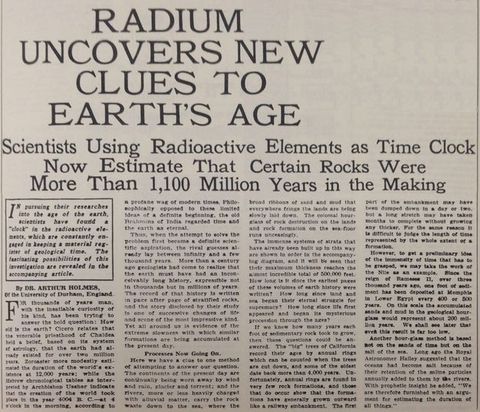
One of Nash’s natural science books, The Worship of Nature by James George Frazer, is a volume which from its opening pages contemplates atoms and electrons, “the imperceptible particles of matter”, with reference to works by Soddy and by the physicist William Bragg, whose 1912 Studies in Radioactivity preceded his use of X-rays to analyse crystal structure. Nash marked the margin of the text adjacent to an idea that resonates with his exploration of pattern, and the tendency of his work to manifest seamlessness between abstract and material modalities, with no apparent contradiction between these modes: “both theories, the materialistic and the spiritualistic, aim at explaining the reality of a world beyond the immediate data of sense.”26
26Nash made streams of photographs observing and visualizing sequences and patterns made “by design” and otherwise: the ploughed earth*,* a cobbled road, the rhythms of a dry stonewall, the surface of the sea (fig. 9. fig. 10, fig. 11, fig. 12). The photographs bestow these overlooked forms of the earth with new intrigue, signalling the discovery of long “invisible” processes. Nash’s preferred medium to capture these patterns is apposite: a chapter in Holmes’ The Age of the Earth addressing radioactivity opens by describing the photographic plate and Henri Becquerel’s discovery of emanation. Holmes writes that, “uranium salts and minerals give out invisible rays which are capable of penetrating black paper and of revealing their existence by their effect on a photographic plate wrapped within it.”27
27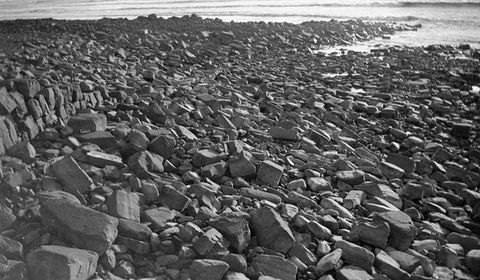
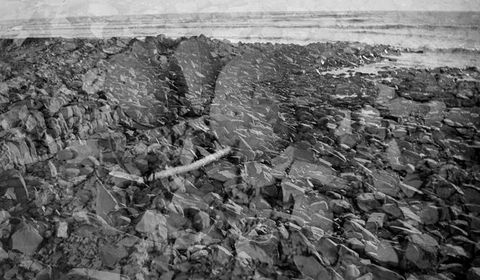
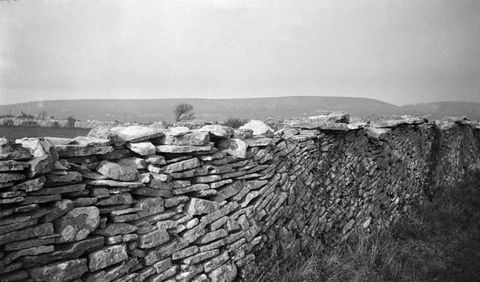
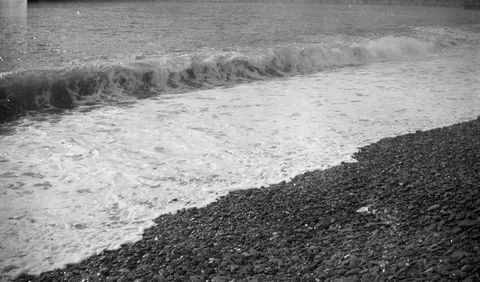
There is a darker aspect here too: in 1938, German scientists split the nucleus of a Uranium atom freeing enormous explosions of energy. The British and American collaboration, The Manhattan Project, worked to develop an atomic bomb and the spectre of this invention loomed in the public imagination. A 1939 letter to The Times speculated on the threat of “a death ray; some super-atomic bomb”.28 One journalist described how the weapon, used by the enemy, "might destroy the whole world—even Germany!"29The very same discoveries that had animated the earth were pointing towards a “dreadful miracle” (Nash’s words) to which Nash alludes in his 1945 Flight of the Magnolia.30 On 7 August 1945, The Times described how scientists were harnessing the “basic power of the universe”, or to use Truman’s phrase, “the force from which the sun draws its power”. Viewed with this contemporary understanding of ubiquitous radiation in mind, a set of Nash’s 1940s landscapes—saturated as they are in colour and viscous rays—seem to evoke the legion processes of the radiating sun and land (fig. 13, fig. 14, fig. 15).
28
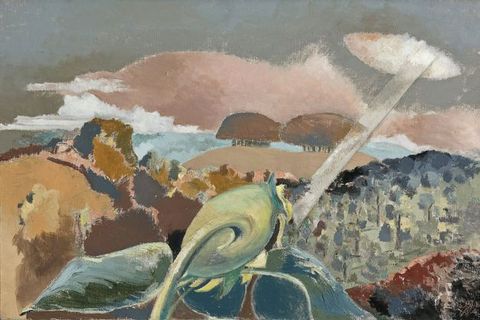
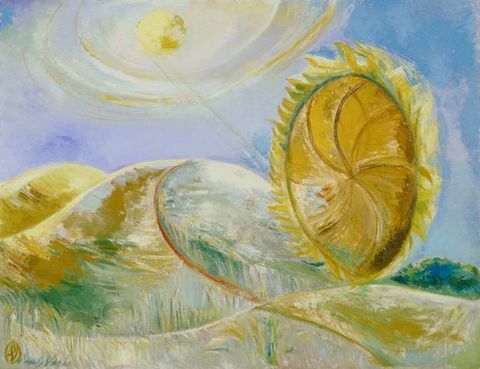
The Real Object
The artist’s engagement with the rediscovered land and earth can be traced in his work with found objects. In 1936, Nash cited and reflected on a review of his sculpture Found Object Interpreted, exhibited that year as part of the International Surrealist Exhibition in London, which it described as, “an awkward object to have knocking around in the unconscious”. “From that little remark,” Nash retorted in The Architectural Review, “anyone might say to himself, oh, so that is what Mr Nash finds in his unconscious; whereas, actually, I found it on the Romney Marsh.”31 Nash’s prosaic response is not only a joke, and I propose that it should be heard in its fullest geological sense: Nash’s found object and unconscious thoughts derive not from the individual psyche, but from the geological land.
31André Breton described the surrealist object as deriving from dreams or the waking unconscious. He celebrated the capacity of such objects to unleash and vitalize powers of invention, and to “depreciate those objects of ‘usefulness’ which clutter the so called real world”.32 In his 1937 essay, “The Crisis of the Object”, Breton describes the disruptive, perturbing potential of surreal objects in the problematic context of modern rationality and its “unprecedented desire to objectify”. He alludes to the “marvellous” quality of such disruption, derived from dream and the unconscious, as distinct from the marvellous impulse of romanticism, which he calls “the urge to coalesce the mind and the tangible world, which led to the inauguration of the rationalist era.”33 Breton was interested in an experience of the marvellous that is not romantic, theological, and ontological, but rather one that is epistemological, deriving from the psyche and its irrational dimension as described by Freud. The subjective mind is the source of potential, transformation, and revolution as embodied in Breton’s object.
32By contrast, Nash’s marvellous objects, his animate bleached stones, illuminated monoliths and minerals, his nests of the phoenix rising, derive from far beyond the limits of the subject and psyche (fig. 16, fig. 17). In the mid-1930s, Nash resided in Dorset, on the Jurassic coast of England, over an extended period and his experimental work with objects was exuberant. He collected stone, flint, driftwood, objects foremost derived from the processes of the land, which he handled, studied, posed, and documented. Dorset was a revelation for Nash, as presented in the artist’s 1936 Dorset: Shell Guide, one of a series produced for motorists, which closely articulates his sense of the landscape as a geological and surrealist object. In it, he describes seeing “Charlbury at twilight—cut against the afterglow, as to experience an almost unnerving feeling of the latent force of the past.”34
34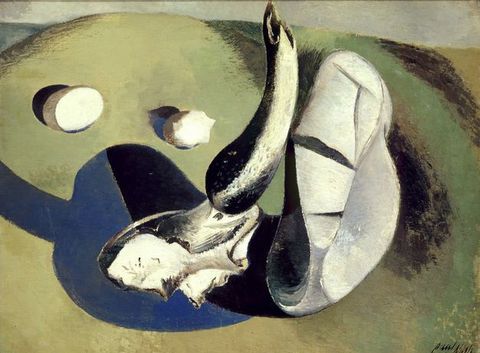
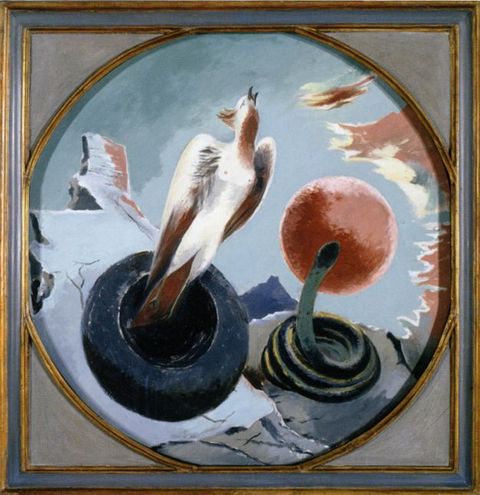
The guide is a vivid encounter with vast, uncanny time and matter whose scale dwarfs that of the human experience. Its cover and endpapers feature astonishing coastal formations and montages created by Nash of fish fossils lifted from Purbeck Limestone, alongside the fossil of a Dapedius, an extinct primitive ray-finned fish, that had been found at Lyme Regis. The images accentuate a marvellous confusion between nature and design. Also featured in the Guide are the patterned head of an adder, the scaled-up form and markings of a pine hawk moth, and a monstrous head of an ichthyosaurus (fig. 18, fig. 19, fig. 20, fig. 21, fig. 22, fig. 23). The Dorset: Shell Guide is replete with the fantastic natural forms of the Jurassic coast: the folded limestone strata of Stair Hole, the implausible land formations of Lulworth Cove, Durdle Door, and Chesil bank, which were in his words, “the result of a mystical judgement called the law of compensation”.35
35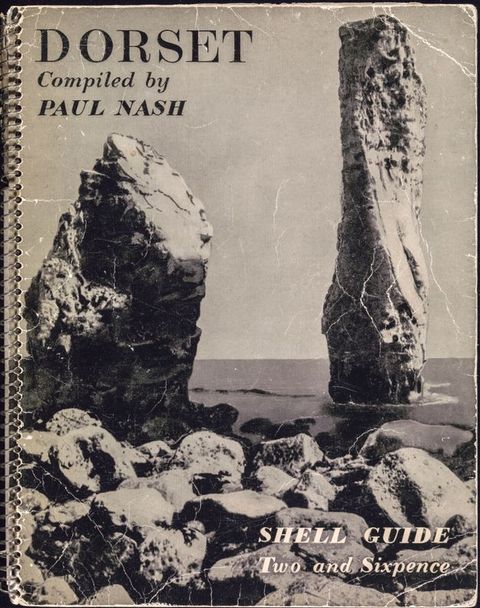


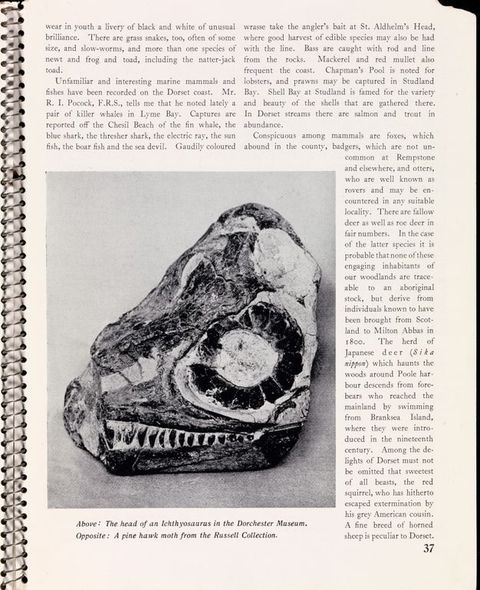

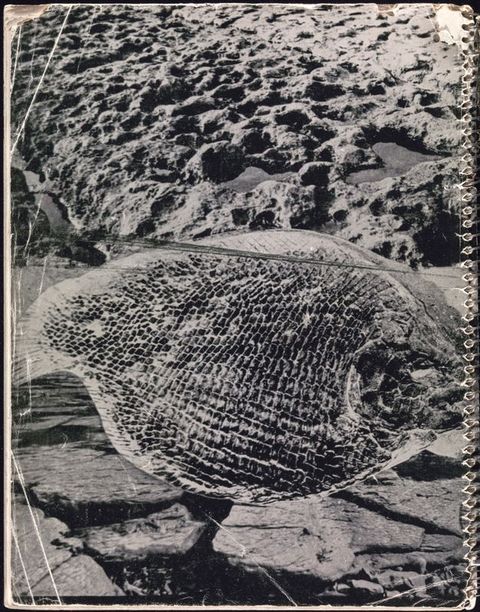
A new link, articulated by Sarah Fill, between the Dorset: Shell Guide and the materialism of Georges Bataille aids the task of interpreting it in a geological context.36 Bataille, the “debaser” of Surrealism, produced the journal Documents from 1929–1930, and pursued an alternate trajectory to Bretonian Surrealism. In his view, Breton’s notion of human irrationality was idealizing and sublimated the base, perverse, and violent—a material irrationality into which he ventured.37 Nash too was interested in this “underside”, a corrective to the bias of Bretonian Surrealism, and he was engaged with Documents.38 Documents and the Dorset: Shell Guide have been described as sharing an anti-humanist sentiment. In the words of Sarah Fill, Nash’s guide made “the nation’s ancestors appear as primitive monsters”.39
36Nash’s proposed anti-humanism, or rather his venturing beyond the bounds of an anthropocentric surrealist marvellous, might be read in a way that is mindful of the artist’s repeated efforts to distinguish his approach from those centred around the Freudian unconscious. The historian Stephen Gould has noted that Freud “in one of history’s least modest pronouncements”, describes a set of “great outrages” upon the “naïve self-love” of humanity. The first was “the realization that the earth was not the centre of the universe, the second, relegation to a descent from the animal world; the third, Freud’s own discovery, the loss of the illusion that we at least possessed rational minds.” He points out that this neglects another great outrage—the displacement of the human from the centre of the temporal realm by the discovery of deep time.40
40Bataille’s explorations revel in Freud’s theory and its base material extrapolations, yet Nash’s encounters with objects are better understood amidst the expanses of deep time and the radioactivity of the material land. To the chance encounter of the surrealist psyche, its coming revolution derived from the fleeting experience of the human unconscious, Nash brings the “sublimated” or rationally marginalized reality of a colossal geological time. The uncanny of the Dorset: Shell Guide derives from the accident of encountering a scintillating geological real.
The new land was also understood as an active chronometer with regular and even rhythm—its minerals "timekeepers of the earth’. Nash opens his guide to the animate “face of Dorset” in metre, with an excerpt from Thomas Hardy’s An August Midnight:
A shaded lamp and a waving blind
And the beat of a clock from a distant floor:
On this scene enter—winged, horned and spined—
A longlegs, a moth, and a Dumbledore:
While 'mid my page there idly stands
A Sleepy fly, that runs its hands …
Thus meet we five in this still place
At this point of time, at this point in space …
Mary Ann Doane describes the increasing reification and standardization of time during the early twentieth century, the “temporal demand” of modernity.42 As this abstracted demand looms large and the contingency of the surrealist object is but an ephemeral release from it, Nash’s found object, alive with the beat of real time, derives from far beyond any such duality.43 It is a vision that does not accord with the anthropocentric time of modernity, and exceeds the chance encounter. Nash’s marvellous is not ephemeral, conditioned by the subjective unconscious—it is infinite.
42In grappling with this marvellous, Nash’s work is ontological enquiry and description, hand in hand with the geologist whose concerns and queries are shared. Nash’s Equivalents for the Megaliths, when read in relation to questions about the age of the Earth, and geophysical efforts to solve arcane equations that might date primordial rocks, seems to present such stones with the elegance of a solved mathematical problem. This origin painting has none of the drama or turmoil of the nineteenth-century deluge scenes produced by Nash’s forebears, at a time of attempts to reconcile the biblical creation narrative of the great flood with the founding insights of geology. In place of catastrophic diluvial forces and unwitting human figures, Nash’s painting alludes to the origin as a balanced equation, discerned by virtuoso human perception. It has the “irrational poise” of Nash’s “poised objects”, in possession of exquisite and improbable design, a quality of balance that teeters on the brink (fig. 1, fig. 24).
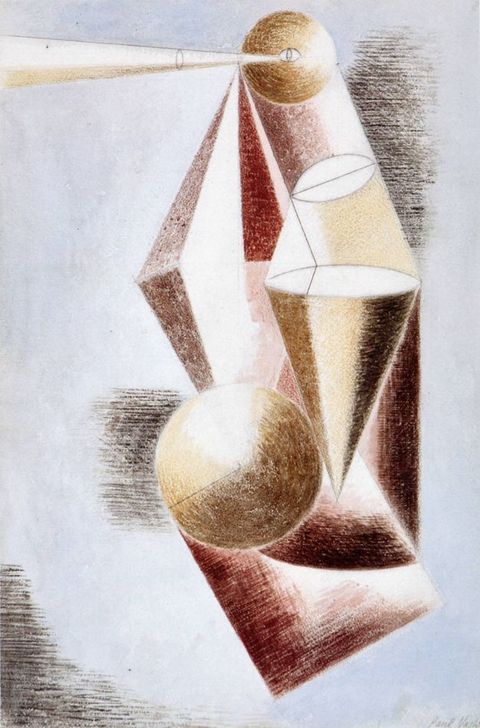
The work indicates a vertiginous shift of dimensions, such that time and space are stretched, enlarged, flattened, transformed. The solid modern monoliths appear here from a high and scaled-back perspective as two-dimensional remains in the land, equivalent to the megaliths amidst a vast new timescale. The scene appears as if from some distant time or space, wherein modern art objects, human remains of mysterious ritual value, stud the land. Herein, the work not only poses as archaeological and geological material, it also hints at its own status being actual geological material; the abstraction of the work of art is construed as part of material geological reality.
What is the position of the human in this encounter? Does the archaeological nature of these megaliths imply a potential future without a human vantage point? The work is a captivating geological problem and mathematical hieroglyph. As does Nash’s oeuvre more broadly, it makes a virtue of the curiosity that sustains the adventure of the guessing mind:
The Flightless Bird
To conclude, I aim to solve one rich geological curiosity among many posed by Nash’s oeuvre. Nash’s Nest of Wild Stones and his 1937 written piece of the same name are characteristically evocative of the connections between stones, mathematical harmony, and deep time (fig. 25). Nash says of the stones in question:
45One may find a pair almost side by side. Inseparable compliments, in true relation … I found them that afternoon on the Sussex Downs, during an attempt to remember whether Edward James lived at East or West Dean. That problem was not then solved, but so soon as my stones came into my hands their equation was solved and they were united forever.45
Another passage, in Nash’s “Unseen Landscapes”, illuminates the title of the work: he refers to “the nests of giant birds … scattered groups of fantastic nests … a sanctuary for Moas.”46 The Moa is a giant flightless bird, extinct, that once roamed and dominated the forests of New Zealand.
46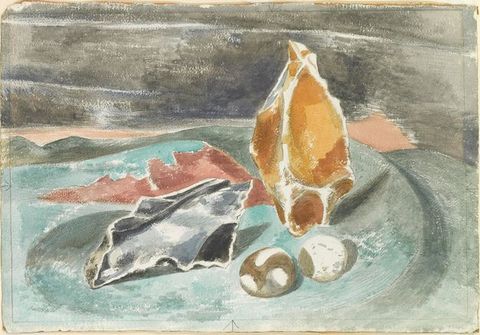

Elsewhere, in William Corliss’ Unknown Earth: A Handbook of Geological Enigmas, a striking discovery of stones is described, with words from Professor Lee, of the Geological Survey, first published in Science, in 1924:
Little heaps of semi-precious stones, scattered over the plains and hills. Nest-like enigmas, which, following investigation are understood to have been collections by extinct birds for use to grind food in the gizzard. Where it lay down to die at last, the pebbles endured after even its bones had disappeared. Hence the little heaps of rounded chalcedony, quartz, chert, jasper and quartzite (fig. 26).
The extraordinary discovery of the precious stones of the Moa captivated Lee, who remarks on:
Nash’s “Nest of Wild Stones” too is marvellous geological enigma, legible stones, deciphered in the field, alive with mathematics and the turn of a conjuror’s hand.
In a context where geophysicists read the startling radioactivity of the land and worked mathematical equations to put a vastly ancient and sensational new age on the rocks of the earth, Nash’s landscape works, fraught with mathematical problems, equations, stones and bones, resonate afresh, beyond the confines of the Modern. Nash’s work poses as a geological problem, implicating the art works as vital geological remains and training the eye of the beholder to marvellous geological mystery. In describing and adventuring in a new geological consciousness, alongside empirical geology, Nash engages with an effable geological reality, channelling and revitalizing a British tradition. Nash’s landscapes are prescient of and suggestive to new modes of engagement in the current context of geological discovery, of a geological age of man, and the landscape now.
Acknowledgements
With thanks to Professor Ysanne Holt and to the organising team of the conference Landscape Now at the Paul Mellon Centre. Also with thanks to HKW Berlin and the Art Fund for their support of this research.
About the author
-
Anna Reid is a curator and writer who is completed her doctoral project with the support of the University of Northumbria. Her dissertation “Wild stones: British landscape and Geological Enigma” rereads materials of the British landscape tradition via the conditions described by recent geological discoveries. Anna worked as Director and also Curator at commissioning organisation Pavilion from 2006–2016. She has a broad experience in producing projects with artists including Lucy Skaer, Eva Stenram, Céline Condorelli, Aurélien Froment, and Mathieu Kleyebe Abonnenc. Anna holds an MA from Goldsmiths College, University of London and a BA from the University of Cambridge. She now works as Head of Research for the Paul Mellon Centre.
Footnotes
-
1
Paul Nash, “Contribution to Unit One”, in Andrew Causey (ed.), Paul Nash: Writings on Art (Oxford: Oxford University Press, 2000), 107–110. ↩︎
-
2
I make this argument at greater length in Anna Reid, “The Nest of Wild Stones: Paul Nash’s Geological Realism”, Visual Culture in Britain 19, no. 2 (2018): 189–215. ↩︎
-
3
Emma Chambers, “Introduction”, in Emma Chambers (ed.), Paul Nash (London: Tate, 2016), 11. ↩︎
-
4
Charles Harrison, “England’s Climate”, in Brian Allen (ed.), Studies in British Art: Towards a Modern Art World (London: Yale University Press, 1995), 207–223. ↩︎
-
5
The Book of Job cited in Arthur Holmes, “The Radioactive Timekeepers of the Rocks”, in Arthur Holmes (ed.), The Age of The Earth: An Introduction to Geological Ideas (London: Ernest Benn, 1927 [1913]), 55–75. ↩︎
-
6
Martin Rudwick, Earth’s Deep History: How It was Discovered and Why It Matters (Chicago, IL: University of Chicago Press, 2014), 235–241. ↩︎
-
7
Oliver Lodge, “Revolutionary Discoveries”, The Listener, 16 January 1929, Science section, 11. ↩︎
-
8
James Jeans, The Mysterious Universe (Cambridge: Cambridge University Press, 1930). ↩︎
-
9
The American geochemist, Clair Patterson arrived at 4.5 billion years in 1953—this radiometric date still stands as the most accurate. ↩︎
-
10
Rudwick, Earth’s Deep History, 235–241. ↩︎
-
11
Words spoken by Sollas and recorded in: J.W.S. Rayleigh, William Sollas, J.W. Gregory, and Harold Jeffreys “The Age of the Earth”, Nature 108, 13 October 1921, 217–218. ↩︎
-
12
Rebecca Bedell, “The History of The Earth: Darwin, Geology and Landscape Art”, in Diana Donald and Jane Munro (eds), Endless Forms: Charles Darwin, Natural Science and the Visual Arts (London: Yale University Press, 2009), 49–77. ↩︎
-
13
Noah Heringman, Romantic Rocks, Aesthetic Geology (Ithaca, NY: Cornell University Press, 2004), 94–137. ↩︎
-
14
Stephen Jay Gould, Time’s Arrow Time’s Cycle: Myth and Metaphor in the Discovery of Geological Time (London: Harvard University Press, 1987), 4–15. ↩︎
-
15
For example, of the books collected by Nash, The Universe by Félix Archimède Pouchet is an in depth guide to the principles of geology; The Atmosphere by Camille Flammarion is an illustrated exploration of such phenomena as sun halos, snow crystals, the refraction of light through raindrops or emanations of phosphoretted hydrogen gas, and an in-depth description of the geomorphic processes of the wind, atmospheric temperature, “water-clouds-rain” and thunderstorms; The Heavens by Amédée Guillemin details processes of tides, eclipses, gravity, and meteoric form; Nash arranged, illustrated, and retained a “Sun Calendar” for the year 1920. ↩︎
-
16
Nash, “Contribution to Unit One”. ↩︎
-
17
David Mellor, “A Spectral Modernity”, in Emma Chambers (ed.), Paul Nash (London: Tate, 2016), 23–33. ↩︎
-
18
Holmes, “The Radioactive Timekeepers of the Rocks”. ↩︎
-
19
Lodge, “Revolutionary Discoveries”. ↩︎
-
20
Paul Nash, “Unseen Landscapes”, in Herbert Read (ed.), Outline, an Autobiography and Other Writings (London: Faber & Faber, 1949), 229–231. ↩︎
-
21
Félix Archimède Pouchet, The Universe (or the Infinitely Great and the Infinitely Little) (London: Blackie and Son, 1885), see, for example, 3–38, 502–510, and 537. ↩︎
-
22
Nash, “Unseen Landscapes”. ↩︎
-
23
Arthur Holmes, “Radium Uncovers New Clues to Earth’s Age”, The New York Times, 6 June 1926. ↩︎
-
24
Holmes, “The Radioactive Timekeepers of the Rocks”. ↩︎
-
25
Inga Fraser, “‘From a Sheet of Paper to the Sky’: Pattern in the Work of Paul Nash”, in Emma Chambers (ed.), Paul Nash (London: Tate, 2016), 59–67. ↩︎
-
26
James George Frazer, The Worship of Nature, Vol. 1 (London: Macmillan and Co, 1926). ↩︎
-
27
Holmes, “The Radioactive Timekeepers of the Rocks”. ↩︎
-
28
Anonymous (civilian), “The New Weapon”, The Times, 28 September 1939. ↩︎
-
29
“That Dreadful Atom Bomb”, Press and Journal, 20 August 1943. ↩︎
-
30
Paul Nash, “Aerial Flowers,” in Herbert Read (ed.), Outline, an Autobiography and Other Writings (London: Faber & Faber, 1949), 258–265. ↩︎
-
31
Paul Nash, “The Object”, The Architectural Review (November 1936): 207–208. ↩︎
-
32
André Breton, “The Crisis of the Object”, in Myfanwy Evans (ed.), The Painter’s Object (London: Gerald Howe, 1937), 275–280. ↩︎
-
33
Breton, “The Crisis of the Object”. ↩︎
-
34
Paul Nash, Dorset: Shell Guide (London: Architectural Press, 1936). ↩︎
-
35
Nash, Dorset. ↩︎
-
36
Sarah Fill, “Paul Nash Surrealism and Prehistoric Dorset”, in Emma Chambers (ed.), Paul Nash (London: Tate, 2016), 49–57. ↩︎
-
37
Dawn Ades and Simon Baker (eds), Undercover Surrealism Georges Bataille and Documents (London: Haywood Gallery, 2006). ↩︎
-
38
Sarah Fill describes how Bataille’s thought reached Nash via Edward Burra, in Sarah Fill, “Paul Nash Surrealism and Prehistoric Dorset”, 51. ↩︎
-
39
Fill, “Paul Nash Surrealism and Prehistoric Dorset”. ↩︎
-
40
Gould, Time’s Arrow, Time’s Cycle, 1–3. ↩︎
-
41
Paul Nash, “The Life of the Inanimate Object”, in Andrew Causey (ed.), Paul Nash: Writings on Art (Oxford: Oxford University Press, 2000), 137–139. ↩︎
-
42
Symptomatic is Frederick W. Taylor’s subjecting of the human body to temporal management, see Mary Anne Doane, The Emergence of Cinematic Time, Modernity, Contingency, the Archive (London: Harvard University Press, 2002), 2–11. ↩︎
-
43
Nash, “Unseen Landscapes”. ↩︎
-
44
Paul Nash, “The Nest of Wild Stones”, in Myfanwy Evans (ed.), The Painter’s Object (London: Gerald Howe, 1937), 38–40. ↩︎
-
45
Nash, “The Nest of Wild Stones”. ↩︎
-
46
Nash, “Unseen Landscapes”. ↩︎
-
47
William R. Corliss, Unknown Earth: A Handbook of Geological Enigmas, (Glen Arm, MD: The Sourcebook Project, 1980), 474. ↩︎
Bibliography
Ades, D. and Baker, S. (2006) Undercover Surrealism Georges Bataille and Documents. London: Haywood Gallery.
Anon. (1939) “The New Weapon”. The Times, 28 September.
Bedell, R. (2009) “The History of the Earth: Darwin, Geology and Landscape Art”. In Diana Donald and Jane Munro (eds), Endless Forms: Charles Darwin, Natural Science and the Visual Arts. London: Yale University Press, 49–77.
Breton, A. (1937) “The Crisis of the Object”. In Myfanwy Evans (ed.), The Painter’s Object. London: Gerald Howe, 275–280.
Causey, A. (ed.) (2000) Paul Nash: Writings on Art. Oxford: Oxford University Press.
Chambers, E. (ed.) (2016) Paul Nash. London: Tate Publishing.
Corliss, W.R. (1980) Unknown Earth: A Handbook of Geological Enigmas. Glen Arm, MD: The Sourcebook Project.
Doane, M.A. (2002) The Emergence of Cinematic Time, Modernity, Contingency, the Archive. London: Harvard University Press.
Evans, M. (ed.) (1937) The Painter’s Object. London: Gerald Howe.
Fill, S. (2016) “Paul Nash Surrealism and Prehistoric Dorset”. In Emma Chambers (ed.), Paul Nash. London: Tate, 49–57.
Fraser, I. (2016) “‘From a Sheet of Paper to the Sky’: Pattern in the Work of Paul Nash”. In Emma Chambers (ed.), Paul Nash. London: Tate, 59–67.
Gould, S.J. (1987) Time’s Arrow, Time’s Cycle: Myth and Metaphor in the Discovery of Geological Time. London: Harvard University Press.
Harrison, C. (1995) “England’s Climate”. In Brian Allen (ed.), Studies in British Art: Towards a Modern Art World. London: Yale University Press, 207–223.
Heringman, N. (2004) Romantic Rocks, Aesthetic Geology. Ithaca, NY: Cornell University Press.
Holmes, A. (1926) “Radium Uncovers New Clues to Earth’s Age”. The New York Times, 6 June.
Holmes, A. (1927 [1913]) The Age of the Earth: An Introduction to Geological Ideas. London: Ernest Benn.
Holmes, A. (1927 [1913]) “The Radioactive Timekeepers of the Rocks”. In Arthur Holmes (ed.), The Age of The Earth: An Introduction to Geological Ideas. London: Ernest Benn, 55–75.
Lodge, O. (1929) “Revolutionary Discoveries”. The Listener, 16 January.
Mellor, D. (2016) “A Spectral Modernity”. In Emma Chambers (ed.), Paul Nash. London: Tate, 23–33.
Nash, P. (1936) Dorset: Shell Guide. London: Architectural Press.
Nash, P. (1936) “The Object”. The Architectural Review (November): 207–208.
Nash, P. (1937) “The Nest of Wild Stones”. In Myfanwy Evans (ed.), The Painter’s Object. London: Gerald Howe, 38–40.
Nash, P. (1949) “Aerial Flowers”. In Herbert Read (ed.), Outline, an Autobiography and Other Writings. London: Faber & Faber, 258–265.
Nash, P. (1949) “Unseen Landscapes”. In Herbert Read (ed.), Outline, an Autobiography and Other Writings. London: Faber & Faber, 229–231.
Nash, P. (2000) “Contribution to Unit One”. In Andrew Causey (ed.), Paul Nash: Writings on Art. Oxford: Oxford University Press, 107–110.
Nash, P. (2000) “The Life of the Inanimate Object”. In Andrew Causey (ed.), Paul Nash: Writings on Art. Oxford: Oxford University Press, 137–139.
Press and Journal (1943) “That Dreadful Atom Bomb”, 20 August.
Rayleigh, J.W.S., Sollas, W., Gregory, J.W., and Jeffreys, H. (1921) “The Age of the Earth”. Nature 108, 13 October.
Read, H. (ed.) (1949) Outline, an Autobiography and Other Writings. London: Faber & Faber.
Reid, A. (2018) “The Nest of Wild Stones: Paul Nash’s Geological Realism”. Visual Culture in Britain 19, no. 2: 189–215.
Rudwick, M. (2014) Earth’s Deep History: How It was Discovered and Why It Matters. Chicago, IL: University of Chicago Press.
Shand, P.M. (1939) “Object and Landscape”. Country Life, 3 June.
Selected books and items from the Paul Nash Collection
Flammarion, C. (1873) The Atmosphere. London: Sampson Low.
Frazer, J.G. (1926) The Worship of Nature, Vol. 1. London: Macmillan and Co.
Guillemin, A. (1883) The Heavens (an illustrated Handbook of Popular Astronomy). London: Richard Bentley & Son.
Jeans, J. (1930) The Mysterious Universe. Cambridge: Cambridge University Press.
Nash, P. (1920) The Sun Calendar For The Year 1920. London: The Sun Engraving Company.
Pouchet, F.A. (1885) The Universe (or the Infinitely Great and the Infinitely Little). London: Blackie and Son.
Imprint
| Author | |
|---|---|
| Date | 29 November 2018 |
| Category | Article |
| Review status | Peer Reviewed (Double Blind) |
| License | Creative Commons Attribution-NonCommercial 4.0 International (CC BY-NC 4.0) |
| Downloads | PDF format |
| Article DOI | https://doi.org/10.17658/issn.2058-5462/issue-10/areid |
| Cite as | Reid, Anna. “Paul Nash’s Geological Enigma.” In British Art Studies: Landscape Now (Edited by Mark Hallett). London and New Haven: Paul Mellon Centre for Studies in British Art and Yale Center for British Art, 2018. https://doi.org/10.17658/issn.2058-5462/issue-10/areid. |
